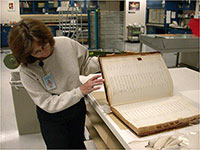
Digitizing Family Papers and Photographs
Digitizing your originals can allow you to view and share your items without handling, which can cause damage. Keep your originals after you digitize them, because digital files have their own preservation risks and can easily be lost. Whether digitizing your family papers yourself or having a company do it, it is important that the originals be handled carefully so they are not damaged in the process.
A few considerations in digitizing:
- For flat paper and photographs, make sure the original fits complete on the surface of the scanner. The lid of the scanner can crush and crease the original if the paper doesn’t fit on the scanner.
- For books, use a copy stand instead of a flatbed scanner. Use book supports, wedges or a cradle so the binding is opened comfortably without force.
- Automatic feed scanners are not suitable for fragile, weak, bent, or valuable papers; papers can jam and become torn in automatic feed scanners.
- File Naming: Use only the letters of the Latin alphabet (A-Z, a-z) when creating alpha-numeric identifications. Don't use spaces, punctuation or symbols. Use hyphens and underscores instead of spaces.
- Add basic Metadata to files: Who, What, Where, and When. Metadata helps find and identify files later in time; there are a number of metadata options.
- Back Up your Files- Follow the 3-2-1 Rule. Three copies, stored on two different media, and one copy located off-site.
For more information on digitizing records:
- Federal Agencies Digitization Guidelines Initiative website - www.digitizationguidelines.gov
- American Society for Media Photographers Best Practices - http://dpbestflow.org/
- Universal Photographers Digital Imaging Guidelines - www.updig.org/
- Wilhelm Imaging Research - www.wilhelm-research.com/
- Image Permanence Institute - www.imagepermanenceinstitute.org/

